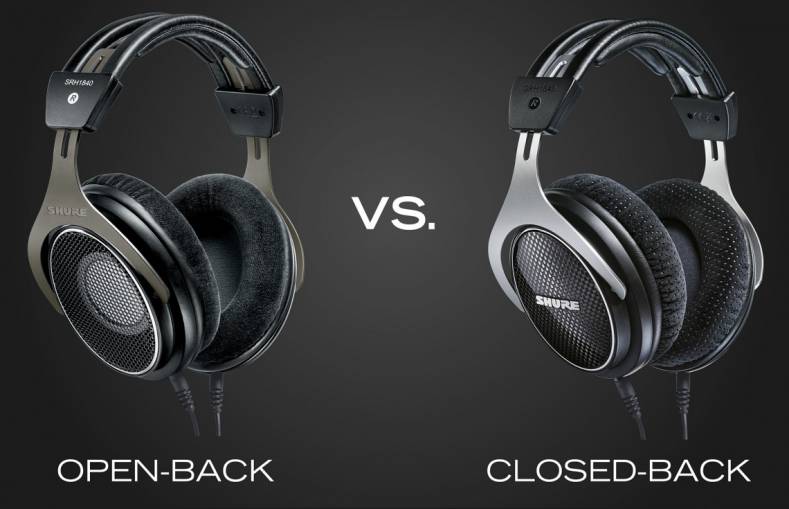Trying to decide between open-back and closed-back headphones? Before making a decision, it makes sense to get a handle on the benefits and drawbacks of each. Basically, you need to be thinking about two things: where you listen to your music and how you like to experience it.
“Where” is self-explanatory. Will you use the headphones at home? On the way to work? At the office? When deciding between open-back and closed-back options, location makes a difference.
Then there's the question of “how” you prefer to listen. Maybe you want to kick back in a quiet place and enjoy every nuance of every song and immerse yourself in your music. Or perhaps you just want to isolate yourself to work on a project or listen without disturbing others.
Nailing down these priorities will help you decide whether open-back or closed-back headphones make the most sense. With that idea in mind, let’s take a closer look at the differences between each types.
What does "Open-back Headphones" mean?
By definition, open-back headphones contain sound-generating drivers that are open to the world outside. You can usually see the driver when you look closely.
The main benefits of open-back design include:
- Space to breathe: If you’re planning to leave the headphones on for a long time, you won’t have to worry about heat and moisture buildup inside the earcups. Your ears can “breathe,” so you’ll be more comfortable during extended sessions.
- The soundstage experience: Your music will sound bigger. When listening to open-back headphones, it feels like music is emanating from all around you – it sounds wider and deeper. This sensation is known as “soundstage,” and it’s one of the primary reasons to choose an open-back model. Hearing a true soundstage is fun, especially if you’re used to simple earbuds or closed-back headphones. If you’re a music lover who values the experience of a quality home stereo system, open-back headphones are for you.
Getting a pair of open-back headphones is a clear sign you’re advancing from a casual listener to someone who thinks a little harder about music. “How do I want to feel when I listen to music?” “What kind of listening experience do I want to have?” If you’re starting to ask these kinds of questions, open-back headphones will be a great choice.
The downsides to open-back headphones? Context, for one thing. Remember how we said that where you listen can affect whether you opt for an open-back or closed-back design? Well, open-back headphones probably aren’t the best choice for the library. They’re open to the world around you, so others might hear your music.
Granted, it all depends on how loud you crank it. If you listen at relatively low volumes, you might get away with open-back headphones at the office.
The other drawback is that you’ll still be able to hear noises from your external environment. If you’re at the bus stop, you’ll still hear traffic whizzing by. If you’re at the coffee shop, you’ll still hear the baristas clinking and clanging away. And so on.
What does "Closed-back Headphones" mean?
When you slip a pair of closed-back headphones over your ears, you’re sealing yourself off from the outside world. In many cases – and this is especially true if you’re using over-ear or noise-canceling headphones – you’re totally isolated with your music.
Solitude? Check. If you’re trying to reach a place where it’s just you and your tunes, closed-back headphones are the way to go.
But maybe you’re not aiming for solitude. Maybe you just need to ensure that nobody can hear your music in an otherwise quiet environment. Closed-back headphones provide that benefit as well. Nobody will know what you’re listening to or how loud you’re listening to it.
In noisy places, a closed-back design also also ensures that sounds around you don’t detract from your listening experience. It can really come in handy if you frequent busy airports or crowded train stations.
Compared to open-back headphones, you don’t get the same live music or soundstage effect. Instead, closed-back headphones take on the character of the enclosure itself. That’s why many designs use anti-resonant materials – to reduce the negative aspects of hearing music inside such a small environment and make the closed-back listening experience more pleasant.
Where and how you listen: The crux of the open-back vs. closed back question
Now that you understand the differences between open-back and closed-back headphones, you need to figure out your priorities. Where will you use the headphones most often? Will it be in a quiet place, or can you get away with having others hear your music a little?
There’s also the question of soundstage. How important is the soundstage experience to you? Does it eclipse the benefit of achieving isolation with your music, or is the latter more important?
Different listeners have different preferences. You might even need different pairs of headphones for different situations, and that’s totally ok! Regardless of your priorities, you’re sure to find at least one pair of headphones that’s perfect for you.
This article originally appeared on AudioAdvice.


